The Phantom
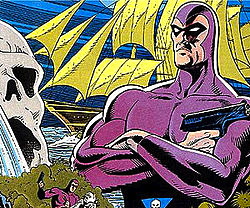
The Phantom: Dark Orbit 2040
 Promotional art for DC Comics The Phantom No. 1 (May 1988), by Joe Orlando and Dave Gibbons.
Promotional art for DC Comics The Phantom No. 1 (May 1988), by Joe Orlando and Dave Gibbons.
The Phantom is an American adventure comic strip created by Lee Falk, also creator of Mandrake the Magician. A popular feature adapted into many media, including television, film and video games, it stars a costumed crimefighter operating from the fictional African country Bangalla.
The Phantom is the 21st in a line of crimefighters that originated in 1536, when the father of British sailor Christopher Walker was killed during a pirate attack. Swearing an oath on the skull of his father’s murderer to fight evil, Christopher started the legacy of the Phantom that would be passed from father to son, leaving people to give the mysterious figure nicknames such as “The Ghost Who Walks”, “The Man Who Cannot Die” and “Guardian of the Eastern Dark“, believing him to be immortal.
Unlike many fictional costumed heroes, the Phantom does not have any superpowers, but instead relies on his strength, intelligence, and fearsome reputation of being an immortal ghost to defeat his foes. The 21st Phantom is married to Diana Palmer, whom he met while studying in the United States; they have two children, Kit and Heloise. Like all previous Phantoms, he lives in the ancient Skull Cave, and has a trained wolf, Devil, and a horse named Hero.
The series began with a daily newspaper strip on February 17, 1936, followed by a color Sunday strip on May 28, 1939; both are still running as of 2013. At the peak of its popularity, the strip was read by over 100 million people each day.
Lee Falk continued work on The Phantom until his death in 1999. Today the comic strip is produced by writer Tony DePaul and artists Paul Ryan (Monday-Saturday) and Terry Beatty (Sunday). Previous artists on the newspaper strip include Ray Moore, Wilson McCoy, Bill Lignante, Sy Barry, George Olesen, Keith Williams, Fred Fredericks, Graham Nolan and Eduardo Barreto.
New Phantom stories are also published in comic books in different parts of the world, among them by Dynamite Entertainment in the United States, Egmont in Sweden, Norway and Finland, and Frew Publications in Australia.
The Phantom was the first fictional hero to wear the skintight costume that has now become a hallmark of comic book superheroes, and was also the first shown wearing a mask with no visible pupils, another superhero standard.
Publication history – Creation
After the success of his Mandrake the Magician, the King Features newspaper syndicate asked Falk to develop a new feature. His first attempt was a strip about King Arthur and his knights, which Falk both wrote and drew. However, King Features turned this down, and Falk developed the idea of The Phantom, a mysterious, costumed crimefighter. He planned the first few months of the story and drew the first two weeks as a sample.
Inspired by his lifelong fascination with myths and legends, such as those of King Arthur and El Cid, as well as modern fictional characters as Zorro, Tarzan, and The Jungle Book‘s Mowgli, Falk envisioned the Phantom’s alter ego as rich playboy Jimmy Wells, fighting crime by night as the mysterious Phantom. Partway through his first story, The Singh Brotherhood, before revealing Wells was the Phantom, Falk changed the setting to jungle and made the Phantom a seemingly immortal mythic figure. Deciding there were already too many characters called the Phantom (including the Phantom Detective and the Phantom of the Opera), Falk had thought of calling his hero “The Gray Ghost” (which later became the name of a Batman character, a fact alluded to in the first episode of Phantom 2040). However, Falk could not find a name he liked better and finally settled on the Phantom.
In the A&E American cable TV documentary The Phantom: Comic Strip Crusader, Falk explained Greek busts inspired the idea of the not showing the Phantom’s pupils when he was wearing his mask. Ancient Greek busts displayed no pupils, which he felt gave them an inhuman, awe-inspiring appearance. In an interview published in Comic Book Marketplace in 2005, Falk said the Phantom’s skin-tight costume was inspired by Robin Hood, who was shown wearing tights in films and on stage.
Newspaper strips
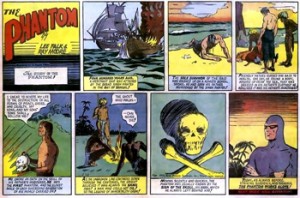 The first Phantom Sunday strip (May 28, 1939). Art by Ray Moore.
The first Phantom Sunday strip (May 28, 1939). Art by Ray Moore.
The Phantom started as a daily strip on February 17, 1936, with the story “The Singh Brotherhood,” written by Falk and drawn first by him, for two weeks, followed by Ray Moore, who was an assistant to artist Phil Davis on Falk’s Mandrake the Magicianstrip. A Sunday Phantom strip was added May 28, 1939.
During World War II, Falk joined the Office of War Information, where he became chief of his radio foreign language division. Moore also served in the war, during which he left the strip to his assistant Wilson McCoy. On Moore’s return, he worked on the strip on and off until 1949, when McCoy succeeded him. During McCoy’s tenure, the strip appeared in thousands of newspapers worldwide, and The Phantom strip was smuggled by boats into the Nazi-occupied Norway during World War II. The word “Phantom” was also used as a password for the Norwegian Resistance, leading the character to receive iconic status in the country.
McCoy died suddenly in 1961. Carmine Infantino and Bill Lignante (who would later draw several Phantom stories directly for comic books) filled in before a successor was found in Sy Barry. During Barry’s early years, he and Falk modernized the strip, and laid the foundation for what is considered the modern look of the Phantom. Barry’s tenure would see Bengalla turned into a democracy, with the character of President Lamanda Luaga being introduced. Barry would continue working on the strip for over 30 years before retiring in 1994, having drawn around 11,000 Phantom strips in total.
Barry’s longtime assistant George Olesen remained on the strip as penciller, with Keith Williams joining as inker for the daily strip. The Sunday strip was inked by Eric Doescher until Fred Fredericks became the regular inker in 1995.
Falk continued to script Phantom (and Mandrake) until his death on March 13, 1999. His last daily and Sunday strip stories, “Terror at the Opera” and “The Kidnappers,” respectively, were finished by his wife, Elizabeth Falk, after the hospitalized Falk had literally torn off his oxygen mask to dictate the adventures. After Falk’s passing, King Features Syndicate began to cooperate with European comic publisher Egmont, publisher of the Swedish Fantomen magazine, which now went from only publishing Phantom stories in licenced comic books to providing the stories for the newspaper strip as well, by adapting their own Phantom comic book stories into the comic strip format. Fantomen writers Tony De Paul and Claes Reimerthi alternated as writers of the newspaper strip after Falk died, with De Paul handling the daily strips and Reimerthi being responsible for the Sunday strips. De Paul would later assume duties as the sole writer of the strip. Some stories have been adapted from comic magazine stories originally published inFantomen.
 Phantom daily strip from 2005. Art by Paul Ryan.
Phantom daily strip from 2005. Art by Paul Ryan.
In 2000, Olesen and Fredericks retired from the Sunday strip which was then taken over by respected comic book artist Graham Nolan, who had previously drawn three covers for issues of Fantomen. A few years later, Olesen and Williams left the daily strip after Olesen decided to retire and artist Paul Ryan, who had worked on theFantomen comic stories and had been a fan of the character since childhood, took over the daily strip in early 2005. Ryan succeeded Nolan as artist on the Sunday strip in 2007. On Sunday July 31, 2011, Eduardo Barretobecame the Phantom Sunday page artist. Barreto died after only a few months of working on the strip however, and Ryan temporarily took over the Sunday page duties again starting with the January 15, 2012 edition, which carried a memoriam for Barreto. The following week’s strip was also handled by Ryan, before Terry Beatty became Barreto’s permanent replacement.
The Phantom is one of few adventure comic strips still published today.
Fictional character biography
In the jungles of the fictional African country of Bangalla, there is a myth featuring The Ghost Who Walks, a powerful and indestructible guardian of the innocent and fighter of all types of injustice. Because he seems to have existed for generations, many believe him to be immortal. In reality, the Phantom is a legacy hero, descended from 20 previous generations of crimefighters who all adopt the same persona. When a new Phantom takes the task from his dying father, he swears the Oath of the Skull: “I swear to devote my life to the destruction of piracy, greed, cruelty, and injustice, in all their forms, and my sons and their sons shall follow me”. The first Phantom married Christina, the daughter of a Scandinavian sea captain, Eric the Rover. The second Phantom married Marabella, the granddaughter of Christopher Columbus.
(The comic sometimes runs flashback adventures of previous Phantoms written by various authors who sometimes confuse Phantom history. Current stories have Marabella as the daughter of Columbus and marrying the first Phantom. As Columbus died in 1506 while, according to the new history, Marabella first meets the Phantom in 1544, this results in another inconsistency, requiring her to be at least 38 years old despite being depicted as in her early 20s. Inconsistencies in storylines and histories are not corrected as a mark of respect to authors, but Falk’s original history takes precedence.)
The Phantom of the present is the 21st in the line. Unlike most costumed heroes, he has no superhuman powers, relying only on his wits, physical strength, skill with his weapons, and fearsome reputation to fight crime. His real name is Kit Walker. References to “Mr. Walker” are in the strip often accompanied by a footnote saying “For ‘The Ghost Who Walks'”, although some versions of the Phantom’s history suggest that Walker was actually the original surname of the man who became the first Phantom.
The Phantom Rings
A signature of the character is his two rings. One has a pattern formed like four crossing sabres, “The Good Mark”, that he leaves on visitors whom he befriends, placing the person under his protection. The other, “The Evil Mark” or “Skull Mark” has a skull shape, which leaves a scar of the corresponding shape on the enemies he punches with it. He wears the Good Mark on his left hand because it is closer to the heart, and the Evil Mark on his right hand. The Skull Ring was given to the first Phantom by Paracelsus. The original owner of the Skull Ring was Emperor Nero of the Roman empire and it would later be revealed that the ring had been made from the nails that hung Jesus to the cross. The Good Mark ring was made after the sixth Phantom founded the Jungle Patrol.
His base is in the Deep Woods of Bengali (originally “Bengalla”, or “Bangalla” and renamed Denkali in the Indian edition), a fictional country initially said to be set in Asia, near India, but depicted as in Africa during and after the 1960s. The Phantom’s base is the fabled Skull Cave, where all previous Phantoms are buried. For a period of time, he also lived with his family in a tree house built by the Rope People — a tribe he had assisted. The Phantom has an Isle of Eden in which he has trained animals that are natural enemies to live in harmony, a mesa in America called Walker’s Table and a castle in the Old World.
The Phantom is the commander of Bangalla’s world-famous Jungle Patrol, who never know his name but answer consistently to his orders. Because of a betrayal leading to the death of the 14th Phantom, the identity of the commander has been kept hidden from members of the patrol ever since. The Phantom uses several ways to stay in contact. These include radio and a safe with a false bottom. On a few rare occasions the Phantom has also visited the patrol wearing his patrol uniform. The sixth Phantom originally formed the Jungle Patrol with the help of former pirate Redbeard and his men back in 1664.
Another character who has aided the modern-day Phantom is Guran, chief of the local pygmy tribe, who are the only tribe to know his true nature. Guran is the Phantom’s best friend since childhood, and a supporter of his cause.
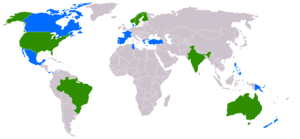 Map of countries printing The Phantom. Green countries have regular Phantom publications, while blue countries print the dailies/Sundays in newspapers.
Map of countries printing The Phantom. Green countries have regular Phantom publications, while blue countries print the dailies/Sundays in newspapers.
The Phantom has two helpers, a mountain wolf called Devil and a horse named Hero. He also has a trained falcon named Fraka. From 1962 on, The Phantom raised an orphan named Rex King, who was later on revealed to be the prince of the kingdom of Baronkhan. He also has two dolphins named Solomon and Nefertiti, and numerous other animals kept on the island of Eden.
In 1978, he married his sweetheart since his days in American college, Diana Palmer, who works at the United Nations. Guran, his best friend since boyhood, was best man. The guests present at the wedding included President Luaga of Bengalla, President Goranda of Ivory-Lana, and Mandrake the Magician (the Phantom would later be a guest at Mandrake’s wedding when he married in 1997).
A year later, twins were born to the Palmer-Walkers; Kit and Heloise.
The Phantom’s family have always played a significant role in the series. His romance with Diana Palmer was an ongoing part of the story from the beginning, and many later stories revolved around the Phantom becoming involved in adventures as a result of young charges including his children.
When the Phantom leaves the jungle, he frequently dresses in a fedora, a trench coat, and sunglasses. The Phantom usually does not allow his unmasked or undisguised face to be seen except by close friends or members of his family. Even readers of the comic have never been shown the Phantom’s unmasked face clearly.
Origin
The story of the Phantom started with a young sailor named Christopher Walker (sometimes called Christopher Standish in certain versions of the story). Christopher was born in 1516 in Portsmouth. His father, also named Christopher Walker, had been a seaman since he was a young boy, and was the cabin boy on Christopher Columbus‘s ship Santa María when he sailed to the Americas. Christopher Jr. became a shipboy on his father’s ship in 1526, of which Christopher Sr. was Captain.
In 1536, when Christopher was 20 years old, he was a part of what was supposed to be his father’s last voyage. On February 17, the ship was attacked by pirates of the Singh Brotherhood in a bay on the coast of Bengalla. The last thing Christopher saw before he fell unconscious and into the sea was his father being murdered by the leader of the pirates. Both ships exploded, making Christopher the sole survivor of the attack. Christopher was washed ashore on a Bengalla beach, seemingly half dead. He was found by pygmies of the Bandar tribe, who nursed him and took care of him.
Some time later, Christopher took a walk on the same beach, and found a dead body there, whom he recognized as the pirate who killed his father. He allowed the vultures flying around the body to eat its meat, took up the skull of the killer, raised it above his head, and swore an oath:
“I swear to devote my life to the destruction of piracy, greed, cruelty, and injustice, in all their forms! My sons and their sons shall follow me.”
After learning the language of the Bandar tribe, Christopher learned that the majority of their people were slaves of the Wasaka, a tribe consisting of what the Bandars called “giants”. Immediately, Christopher walked into the village of the Wasaka, and asked them to set the Bandars free. He was taken prisoner and laid before the Demon God of the Wasaka, Uzuki, who was supposed to decide his destiny. Christopher was tied up and laid on an altar made of stone, where vultures surrounded him. Christopher was quickly saved by a group of Bandar before the vultures or the Wasaka could do him any real harm. They managed to escape from the village of the Wasaka unharmed.
Christopher later learned of a Bandar prophecy that featured a man coming from the ocean to save them from their slavery. He made a costume inspired by the look of the Demon God of the Wasaka and went to the Wasaka village again, this time with a small army of Bandar armed with their newly-discovered poisoned arrows, which were capable of killing a man in a few seconds. The Wasaka, shocked at seeing what many of them thought was their Demon God come alive, were fought down, and the Bandars were finally set free after centuries in slavery. This resulted in a dedicated friendship between Christopher and the Bandars, which would be continued in the generations to come after them.
The Bandars showed Christopher to a cave, which resembled a human skull in appearance. Christopher later carved the features out to enhance this. This Skull Cave became his home.
Wearing the costume based on the Demon God, Christopher became the first of what would later be known as the Phantom. When he died, his son took over for him; when the second Phantom died, his son took over. So it would go on through the centuries, causing people to believe that the Phantom was immortal. These people gave him nicknames including “The Ghost Who Walks” and “The Man Who Cannot Die.”
Mythos
Over the course of more than seventy years’ worth of stories, the back story “legend” of the Phantom grew to become an integral part of the series. The legend of the “Ghost Who Walks” made the character stand out from the innumerable costumed heroes who have battled crime throughout the 20th century, and helped maintain his appeal through to the present day.
Much of the underlying, continuing plots and “themes” of the series focus on the continuing legend of the Phantom. The series regularly quotes the “old jungle sayings” surrounding the myth of the Phantom. Perhaps the most well-known of these is the tradition that anyone who sees the Phantom’s true face without his mask will certainly “die a terrible death”.
Not all stories were set in present time, but included earlier generations. While the costumes looked the same, the weaponry varied with the age, such as revolvers and pirate flintlocks.
The Phantom is feared by criminals over the entire world and knows how to use his frightening image against them.
Kit Walker, the 21st Phantom
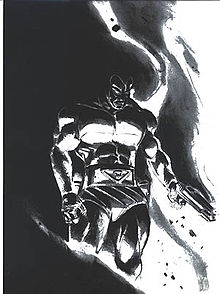 The 21st Phantom, drawn by Jerry DeCaire.
The 21st Phantom, drawn by Jerry DeCaire.
The 21st Phantom’s birth name is Kit Walker, as was the name of many of the Phantoms before him. Kit was born in the Skull Cave, and spent his first years in the jungle of Bengalla. His mother, Maud Thorne McPatrick, who had previously worked as Rita Hayworth‘s stunt double, was born in Mississippi, where Kit went to study when he was 12 years old, living with his aunt Lucy and uncle Jasper in the town of Clarksville.
Here he met his wife-to-be, Diana Palmer. Kit was an extremely talented sportsman and was predicted to become the world champion of many different events (even knocking out the world heavyweight boxing champion in a sparring match when the champion visited Clarksville). Despite the opportunity to choose practically any career he wanted, Kit faithfully returned to Bengalla to take over the role of the Phantom when he received word from Guran that his father was dying from a knife-wound.
One of Kit’s first missions as the Phantom was to find his father’s killer, Rama Singh, who had betrayed and murdered the 20th Phantom by first helping him to blow up a fleet of ships owned by the Singh Brotherhood, only to then stab him in the back, stealing his special gunbelt in the process. The 21st Phantom eventually found him and reclaimed the belt at the island of Gullique, but before he could avenge his father and bring the killer to jail, the desperate Rama blew up his lair, killing himself and his henchmen in the process.
Costume and weapons
As part of the official uniform, the Phantom wears a black mask and a purple skintight bodysuit. He also carries period-appropriate sidearms, currently two M1911 pistols, in a special belt with a skull-like buckle. Falk has insisted that the Phantom only uses his guns to shoot out the guns of his opponents, a fact that writer Peter David was unaware of when he wrote DC Comics‘ 1988 four-issue Phantom miniseries, in which he had the Phantom shoot to wound his enemies. However, there are some early instances of the Phantom using his guns to shoot and kill people (sometimes in self-defence).
While there had been masked crime fighters like the costumed Zorro or the business-suited The Clock, the Phantom was the first fictional character to wear the skintight costume and eyes with no visible pupils that has become a trademark of superheroes. Creator Lee Falk had originally envisioned a grey costume and even considered naming his creation “The Gray Ghost”. It was not until the Phantom Sunday strip debuted in 1939 that the costume was shown to be purple. Falk, however, continued to refer to the costume as gray in the text of the strip on several occasions afterward, but finally accepted the purple color. In a Sunday strip story published in the 1960s it was shown that the first Phantom chose the costume based on the appearance of a jungle idol, and colored the cloth with purple jungle berries.
As part of a modernization of the character in Moonstone Books’ series The Phantom: Ghost Who Walks, the Phantom began wearing a costume made of kevlar.
Enemies
Given his oath to fight all evil in the world, The Phantom faces a vast array of villains. The most dangerous and lasting enemy of the Phantom is the Singh Brotherhood, which have been active for centuries and were responsible for the pirate attack that resulted in the death of Christopher Standish’s father and the beginning of the Phantom legacy. In Egmont’s Phantom comics, the brotherhood has evolved from merely being pirates into a modern company called Singh Corporations, led by Sandal Singh, who is the daughter of former leader Dogai Singh and also the current President of Bengalla.
Another major threat against the Phantom and his country was Kigali Lubanga, the President of Bengalla for several years. Other recurring villainous characters are General Bababu, The Python, Manuel Ortega, Ali Gutalee, Goldhand, Bail, HIM and – in the movie – Xander Drax. The Phantom has also fought numerous crime-organizations such as the Sky Band, the Vultures, Hydra and The Flame.
Comic books – United States
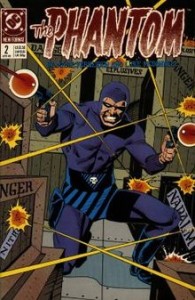 DC Comics The Phantom vol. 2, No. 2 (April 1989). Cover art by Luke McDonnell.
DC Comics The Phantom vol. 2, No. 2 (April 1989). Cover art by Luke McDonnell.
In the United States the Phantom has been published by a variety of publishers over the years. Through the 1940s, strips were reprinted in Ace Comics published by David McKay Publications. In the 1950s, Harvey Comics published the Phantom. In 1962, Gold Key Comics took over, followed by King Comics in 1966 and Charlton Comics in 1969. This lasted until 1977, with a total number of 73 issues being published. Some of the main Phantom artists during these years were Bill Lignante, Don Newton, Jim Aparo and Pat Boyette.
DC Comics published a Phantom comic book from 1988 to 1990. The initial mini-series (dated May–August 1988) was written by Peter David and drawn by Joe Orlando and Dennis Janke. The subsequent series, written by Mark Verheiden and drawn by Luke McDonnell, lasted 13 issues (March 1989 – March 1990). It depicted the Phantom fighting such issues as racism, toxic dumping, hunger, and modern-day piracy. According to Verheiden, the series ended because of licencing issues as much as dropping sales. The final panels of issue 13 saw the Phantom marrying Diana.
In 1987, Marvel Comics published a four-issue miniseries based on the Defenders of the Earth TV series, written by Stan Lee. Another three-issue Marvel miniseries, The Phantom: The Ghost Who Walks (Feb.-April 1995) followed, written and drawn by David de Vries and Glenn Lumsden, it featured the 22nd Phantom, with an updated, high-tech costume. Marvel later released a four-part miniseries (May–August 1995), pencilled bySpider-Man co-creator Steve Ditko, based on the Phantom 2040 TV series. One issue featured a pin-up by the original two Spider-Man signature artists, Ditko and John Romita, Sr.
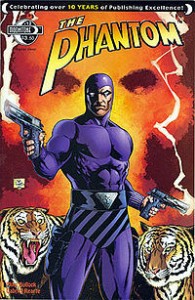 Moonstone Books’ The Phantom#12 cover by Joe Prado.
Moonstone Books’ The Phantom#12 cover by Joe Prado.
The gadgets used by Marvel’s 22nd Phantom were slightly reminiscent of those in Phantom 2040, only less advanced. For instance, while the 2040 Phantom had a talking artificial intelligence built into one of his wristbands, the 22nd’s wristband contained a sophisticated, but clearly present-day, palmtop computer.
Moonstone Books published Phantom graphic novels beginning in 2002. Five books, written by Tom DeFalco, Ben Raab, and Ron Goulart, were published. In 2003, Moonstone debuted a Phantom comic-book series written by Raab, Rafael Nieves, and Chuck Dixon, and drawn by artists including Pat Quinn, Jerry DeCaire, Nick Derington, Rich Burchett, and EricJ. After 11 issues, Mike Bullock took over scripting, with Gabriel Rearte and Carlos Magno creating the artwork before Silvestre Szilagyi became the regular artist in 2007. Bullock’s stories often feature topical issues based on real-life African conflicts. In a 2007 three-part story arc called “Invisible Children”, the Phantom fought a fictional warlord called “Him”, loosely based on Joseph Kony.
In 2006, Moonstone published a retcon of the Phantom’s origin, called Legacy, by Raab and Quinn. That same year, the company published a hybrid comic book and prose book it called “wide-vision”, premiering the format with the Phantom story “Law of the Jungle”. Moonstone also released the first American Phantom annual. A second annual teamed the Phantom up with Mandrake the Magician.
In 2009, Moonstone re-launched the series as The Phantom: Ghost Who Walks, starting with issue 0, a retelling of the origin of the first Phantom. The goal of this launch was to make the comic darker, grittier and more realistic, like the stories of Lee Falk and Ray Moore from the 1930s. It also updated the character of the Phantom by giving him more modern day accessories, and introduced many supporting characters and villains. The Phantom frequently fights reality based enemies in the series, such as modern day terrorists, organ-smugglers and Somalian pirates.
2009 would see Moonstone Books launch the 21 issue maxi-series Phantom Generations, with each of the twenty one Phantoms spotlighted in their own story, crafted by different creative teams including writers such as Ben Raab, Tom DeFalco, Tony Bedard, Will Murray and Mike Bullock. Artists on the project include Pat Quinn, Alex Saviuk, Don Hudson, Scott Brooks and Zeu.
Moonstone also published “Phantom Action”, a story written by Mike Bullock that saw the Phantom meeting Captain Action, a five-issue miniseries in black and white called “The Phantom Double Shot: KGB Noir,” and a two-part miniseries called “The Phantom: Unmasked.”
Dynamite Entertainment debuted the monthly comic book series The Last Phantom in August 2010, to strong sales. The book is written by Scott Beatty and drawn by Eduardo Ferigato, with covers painted by Alex Ross. Featuring a modern reboot of the 21st Phantom, the series tells the story about how Kit Walker, now a philanthropist and head of the Walkabout Foundation, has forsaken his family’s legacy, and shows his journey to become the Phantom again, set in motion when his family is murdered.
Scandinavia and Nordic region
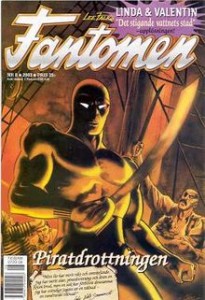 Sweden’s Fantomen #8 (2003). Cover art by Hans Lindahl.
Sweden’s Fantomen #8 (2003). Cover art by Hans Lindahl.
Egmont Publications has published original Phantom stories in a fortnightly Phantom comic book published in Sweden as Fantomen, in Norway as Fantomet, and in Finland asMustanaamio (“[the] Black-Mask”).
The first issue of Fantomen was cover-dated October 1950. Over 1600 issues have been published. Because of limited printers in the 1950’s the Phantom’s costume was printed in dark blue and has stayed that color in Scandinavia ever since.
The first story created originally for the Swedish Fantomen magazine was published as early as 1963, and today the total number of Fantomen stories is over 900. The average length of a Fantomen story is 30+ pages (compared to 20-24 pages for most American comics). Among the most prolific artists and writers that have created stories forFantomen are: Dick Giordano, Donne Avenell, Heiner Bade, David Bishop, Georges Bess,Jaime Vallvé, Joan Boix, Tony DePaul, Ulf Granberg, Ben Raab, Rolf Gohs, Scott Goodall, Eirik Ildahl, Kari Leppänen, Hans Lindahl, Janne Lundström, Cesar Spadari, Bob McLeod, Jean-Yves Mitton, Lennart Moberg, Claes Reimerthi, Paul Ryan, Alex Saviuk,Graham Nolan, Romano Felmang, and Norman Worker. The artists and writers working on these stories have been nicknamed Team Fantomen. n later years, the team have started to experiment more with the character and his surroundings, by having Singh Brotherhood member Sandal Singh taking over as President of Bengalla, giving the Phantom and Diana marriage problems, and exploring the Phantom-canon more.
Egmont are also well known for their numerous historical Phantom adventures, detailing the lives and deaths of former Phantoms and having them appearing in real historic events, meeting countless historic figures in the process. The use of historical adventures ties in with the library of chronicles (diaries) written by past phantoms, consulted by the current phantom as a frame story to tell a flashback story. Similarly, a series of books with chronologically ordered adventures released in Sweden between 1993 and 1999 aimed to replicate this, and covered events from 1536 to 1885 until production was stopped.
Australia
Another country where the Phantom is popular is Australia, where Frew Publications has published a fortnightly comic book, The Phantom, since 1948, celebrating 60 years of uninterrupted publication in September 2008. Frew’s book mostly contains reprints, from the newspaper strips and from Fantomen (in English translation) and other The Phantom comic books, but has on a few occasions also included original stories, drawn by Australian artists, such as Keith Chatto. The editor-in-chief was (until recently) the late Jim Shepherd. Frew’s The Phantom is the longest running comic book series with the character in the world, and is Australia’s best selling comic. The Frew comics are also imported and sold in New Zealand. The comics appear in numerous Perth Royal Show showbags.

